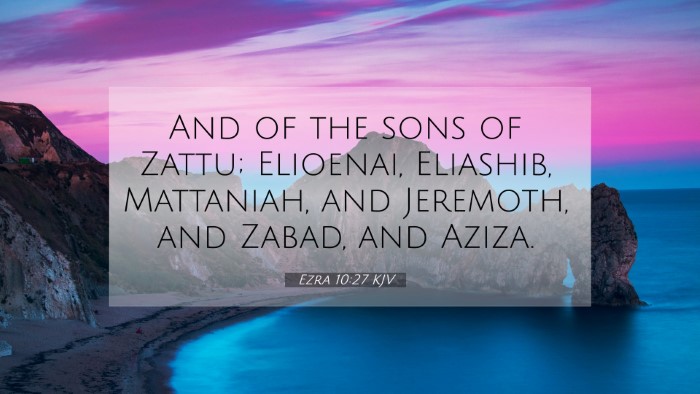Understanding Ezra 10:27
Ezra 10:27 states: "And of the sons of Bebai; Jehohanan, Hananiah, and Zabbai, and the sons of Azgad, Johanan and his brothers, and the sons of Adonikam, the last, and their names were Eliphelet, Jeuel, and Shecaniah." This verse provides a list of individuals connected with specific families returning from exile, highlighting the restoration of Israelite identity.
Verse Context
This verse appears towards the end of Ezra's account of the return from Babylonian exile, wherein many families are documented. These genealogies serve a dual purpose: acknowledging the heritage of those who returned and emphasizing the restoration of the covenant community of Israel.
Thematic Insights from Commentaries
-
Matthew Henry: Identity and Heritage
Henry points out the importance of people's names in Biblical genealogies, which represent their heritage and relationship to God’s promises. The mention of these names signifies that God is fulfilling His promises to the descendants of Israel.
-
Albert Barnes: Covenant Community
Barnes highlights the connection between the returning exiles and the ancient covenant community. The meticulous listing serves as a testament to God’s faithfulness in restoring the nation after exile.
-
Adam Clarke: Restoration of Worship
Clarke emphasizes that the restoration of these families was integral for re-establishing worship in Jerusalem, as each family was a part of the larger community that would reinstate temple worship and rituals.
Cross-Referencing Biblical Texts
Ezra 10:27 connects with several other Bible verses that enhance its meaning:
- Ezra 2:1-67 - Details of the returnees from Babylon.
- Nehemiah 7:6-73 - Also lists those who returned and links to the rebuilding of Jerusalem.
- 1 Chronicles 5:12 - Addresses genealogies and heritage themes similar to Ezra’s records.
- Jeremiah 29:10-14 - Promises restoration to the exiled people.
- Isaiah 44:28 - Prophecies concerning Cyrus allowing the Jews to return.
- Matthew 1:12 - Lists of names connected to Jesus affirming the importance of genealogy.
- Hebrews 11:39-40 - Discusses the faith of past generations awaiting fulfillment of God's promises.
Significance of Cross-Referencing
The connections between Bible verses, such as those seen between Ezra 10:27 and the above references, underscore the intricate tapestry of God's narrative throughout Scripture. To comprehend these connections:
- Tools for Bible cross-referencing can help identify these links.
- A Bible concordance can serve as a guide to find related themes and verses.
- Cross-reference systems provide structured paths to explore scriptural dialogue.
Practical Applications of Cross-Referencing
For those studying the Bible, understanding these interconnections enriches one's grasp of scriptural truths and themes:
- Developing a comprehensive Bible cross-reference study method enhances overall Biblical literacy.
- Identifying connections between Old and New Testament texts fosters a deeper appreciation of God’s continuous work in history.
- Recognition of thematic Bible verse connections can inform sermon preparation and personal devotions.
Conclusion
Ezra 10:27, while seemingly a simple verse, opens the door to profound insights regarding heritage, community identity, and God’s faithfulness in restoration. Engaging in comparative Bible verse analysis helps uncover a rich doctrinal and historical framework crucial for understanding both ancient and ongoing narratives of faith.




